Extremadura offers visitors and an incredible wealth of historical and cultural century-old heritage and truly gorgeous, unencumbered natural beauty. The homeland of some of the most legendary conquistadors boasts a score of UNESCO Heritage SITES across the provinces of Cáceres and Badajoz, including Mérida, Cáceres and Parque Nacional de Monfragüe. Read on for our inside track on the top sights of Extremadura!
Cáceres
The fairytale Old Town of Cáceres is a stunning sight to behold. The medieval historic centre seems to have frozen in time, maintaining the medieval and Renaissance grandeur from centuries past. The architectural ensemble was declared a UNESCO World Heritage Site in 1986 – a well-earned accolade. The walled-in Old Town with its quaint squares, lavish palaces and time-worn, cobblestoned streets bursts with history and legends. Many different peoples have called Cáceres home throughout history and they each have left their own particular imprint on the cultural and architectural make up of this glorious city.

The plethora of juxtaposed, historical landmarks includes: Late Stone Age paintings at Cueva de Maltravieso; Roman and Baroque-style gateways; Jewish Quarter; Moorish watchtowers; and Mudejar façades alongside Renaissance palaces. Cáceres is an artistic and architectural stunner thanks to the hodgepodge of cultures and styles that prevailed at a given time in history.
Cáceres is an incontestably striking place and Hollywood took notice. Many of the historic centre’s most iconic landmarks appear in the acclaimed TV series Games of Thrones. Explore Plaza Mayor, Arco de la Estrella, Torre de Bujaco, Concatedral de Santa María, Palacio de los Veleta and Palacio de los Golfines. These are just a few of the many sights interspersed in and around the Old Town.
Mérida
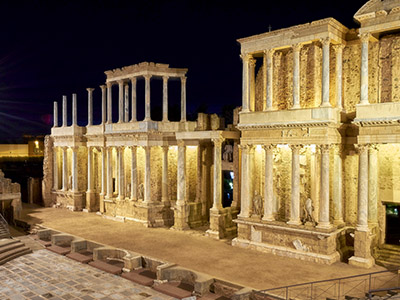
Nothing can prepare you for the visual feast that is Mérida. Dubbed ‘Little Rome’, the once, second most important city of the Roman Empire offers visitors the chance to see some of the best-preserved Roman ruins in all of Spain. The city is no ghost town either. Vibrant and energetic, it boasts a mixture of contemporary buildings, housing bars and restaurants, alongside Roman temples and amphitheatres.
There is no better way to experience the ways of the Romans than by attending the outdoor Mérida Classical Theatre Festival. Sit under the stars in a 2,000-year old Roman amphitheatre and enjoy a classical performance the way it was meant to be experienced. The city boasts also the longest Roman bridge of Antiquity; a 750-m footbridge crossing over the mighty Guadiana River; and a 9th-century Moorish fortress, considered the most ancient of the Iberian Peninsula. Mérida harbours a fascinating architectural complex of Roman and Moorish historic landmarks – no surprise it was declared a UNESCO World Heritage Site.
Some of the key sights include: the Roman amphitheatre; the National Museum of Roman Art; Templo de Diana; Acueducto de los Milagros; and the Basílica de Santa Eulalia.
Badajoz
The city of Badajoz sits near the Portuguese border and affords a strategic location that more than one legion fought to control throughout its century-old history. A bastioned defensive wall and fortress were erected to protect the city from attacks. Badajoz was originally founded in 875 by the Caliph Ibn Marwan and the Moorish influence is still very much present in the architecture around the city.
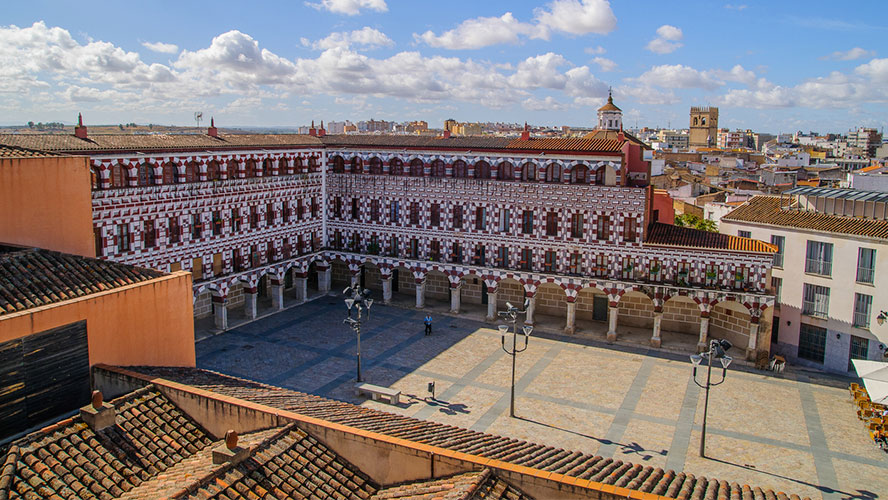
These historic landmarks include the colossal, perfectly preserved Alcazaba del Cerro de la Muela, a designated Cultural Heritage Site. The 12th-century, oval-shaped defensive wall is dotted with watchtowers, including the iconic Torre de Espantaperro which was used as a model to design the Torre del Oro in Seville.
Other noteworthy sights include: the Palacio de los Condes de la Roca which houses the Provincial Archaelogical Museum; Plaza de San José; Plaza Alta; and Plaza de España which boasts the Majestic Catedral de San Juan Bautista, Puerta de Palmas and Iglesia de San Agustín.
Plasencia
The picturesque city of Plasencia is located at the foot of the lush Valle del Jerte, just north of Cáceres. The remnants of the Old Town are distinctively medieval though the city was inhabited by Celts and Romans. Use Plaza Mayor as your launchpad. From there, meander along the narrow streets, flanked by historic palaces, convents, churches, and sections and gateways from a 12th-century defensive wall. Don’t forget to visit the splendid Cathedral; the 15th-century Palacio de los Marqueses de Mirabel; and the aqueduct.
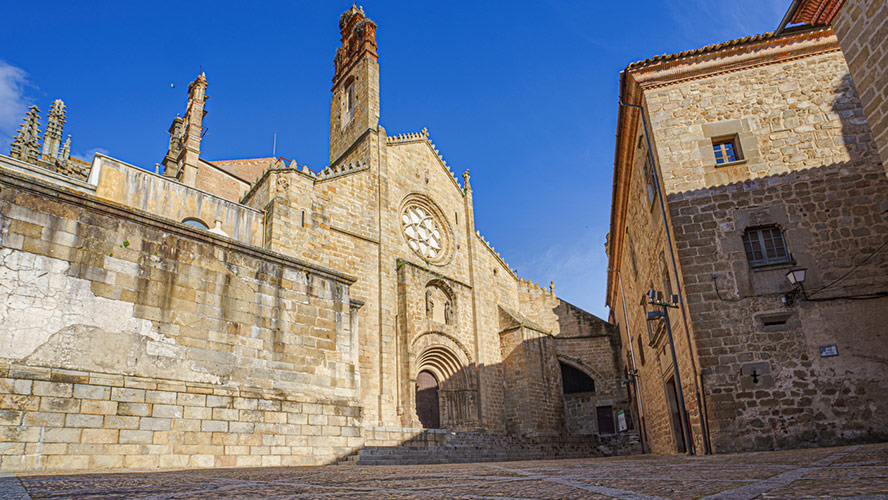
Trujillo
Situated in the province of Cáceres, Trujillo is a charming town filled with historic buildings. Many of its majestic civil buildings were commissioned by local conquistadors who returned wealthy from the New World. The town’s most legendary conquistador is Francisco Pizarro.
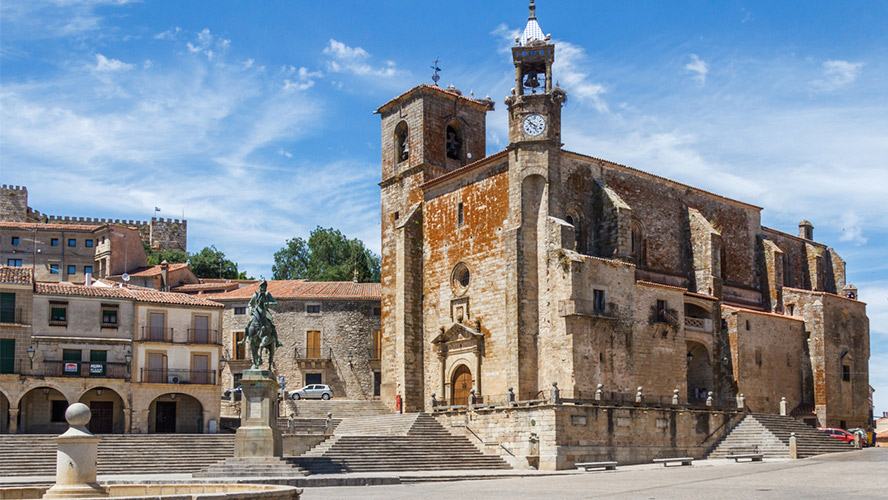
In fact, the emblematic statue of Francisco Pizarro on horseback in the centre of Plaza Mayor is probably the most photographed monument in Trujillo. Climb up to Cabeza del Zorro to visit the 10th-century Moorish fortress and defensive walls, built by the Caliph of Cordoba. From atop the battlements, you will be treated to sweeping views of the lush countryside. Other not-to-be-missed monuments include the churches of Santa María la Mayor, San Martín and San Francisco.
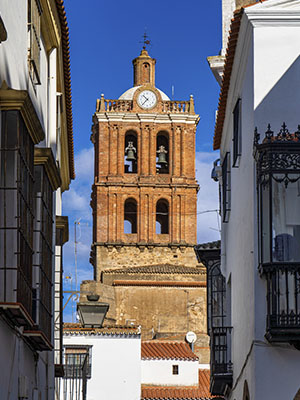
Zafra
This century-old village is one of the most picturesque towns in the province of Badajoz thanks to its enthralling, medieval historic Old Town. Zafra still retains its tradition of livestock farming that dates back as far as the 14th century. Every October, the town hosts the Zafra International Livestock Fair, considered one of the most important trade shows in Europe. Zafra experienced substantial growth during the 15th century when it acted a frontier town between the Islamic caliphates of Seville and Badajoz.
One of Zafra’s most singular landmarks is the impressive Gothic Palace of the Dukes of Feria. The historic centre is filled with beautiful Andalusian-type patios, convents, colourful façades and cobble-stoned streets. The town became a prosperous trading hub following the conquest of the New World which gave rise to popular fairs and markets. Some of the town’s top attractions include: Plaza Grande; Plaza Chica; Puerta del Cubo; Puerta de Jerez; Iglesia de la Candelaria; and Convento de Santa Ana.
Las Hurdes
The remote enclave of Las Hurdes was once believed to be the home of evil spirits and ferocious people. However, these were just old wife’s tales based on the extreme poverty that invaded this area. In fact, Las Hurdes is nestled in an astonishing natural setting. Many of the small villages preserve the traditional slate-and-stone architecture, dubbed ‘black architecture’, that permeates the area. Some of the best villages to visit include Aceitunilla, El Gasco, Riomalo de Arriba and Ovejuela. Discover the contrasting backdrop of rolling plains, towering mountains and plunging valleys, such as Meandro de Melero. It also harbours beautiful waterfalls and springs such as Chorro de Miacera and Chorrera de Arrobatuequilla.
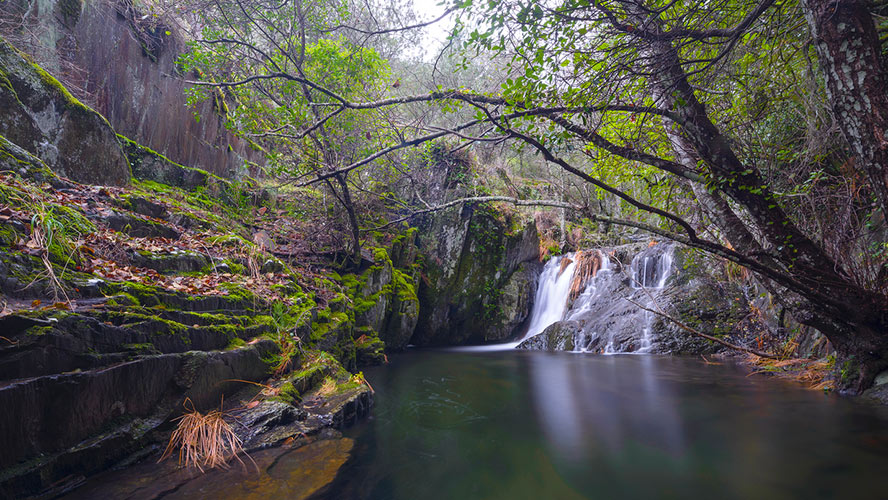
Garganta de los Infiernos
Garganta de los Infiernos is a natural reserve located in the Valle del Jerte, huddled between Sierra de Gredos and Jerte River. The area abounds with waterfalls, brooks and streams. Some of the most popular destinations include Los Pilones and Chorrero de la Virgen which can be reached after a leisurely hike through evocative landscapes.
Guadalupe
The origin of this fetching village dates to the 13th century when a peasant discovered a statue of the Virgen of Guadalupe. According to legend, the statue had been hidden from Moorish invaders in the 8th century. A small hermitage was built on the site of the discovery and became known as Our Lady of Guadalupe. In 1340, King Alfonso XI founded a monastery which was the cornerstone to the development of the village.
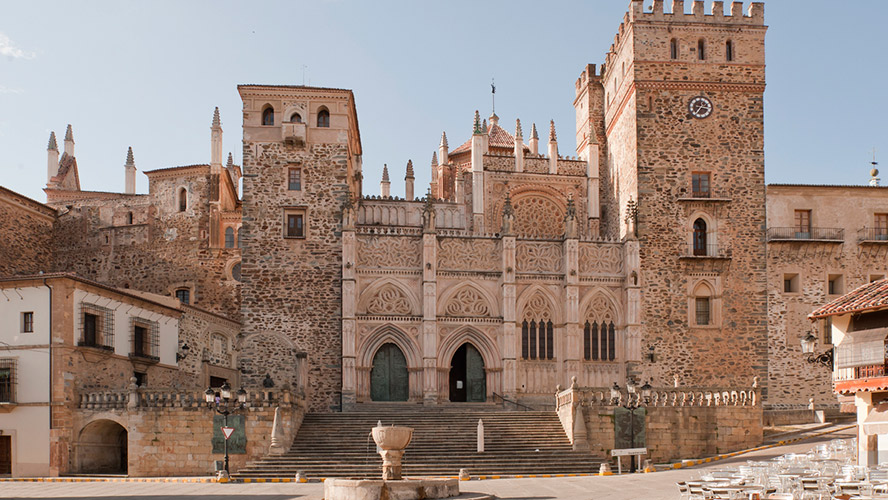
Monasterio de Guadalupe is a 15th-century architectural masterpiece and was designated a UNESCO World Heritage site. Many key figures of Spanish history visited the monastery, including Queen Isabella the I of Spain. The first two indigenous persons Christopher Columbus brought back from his first expedition to the New World were baptised here. The ecclesiastical building houses three museums filled with historical objects and works of art. Visitors can even get a glimpse at the ancient living quarters of the monks.
Alcántara
Psst..don’t tell anyone but Alcántara is Extremadura’s best hidden treasure. The ancient town hosts an annual Classical Theatre Festival which should be a hint of its Roman origins. One of the town’s top attractions includes a magnificent Roman bridge which spans the Tagus River. The six-arched bridge was built to facilitate the transport of metals by order of the Roman Emperor Trajan in the 2nd century and represents an extraordinary example of Roman civil engineering. You will also see the ruins of ancient Roman temple by the bridge. The town sits atop a hill and has many other noteworthy attractions, including: Conventual de San Benito, a 16th-century impressive monastery; Plaza de la Corredera; and Iglesia de Santa María de Almocóvar, a stunning example of Romanesque architecture.
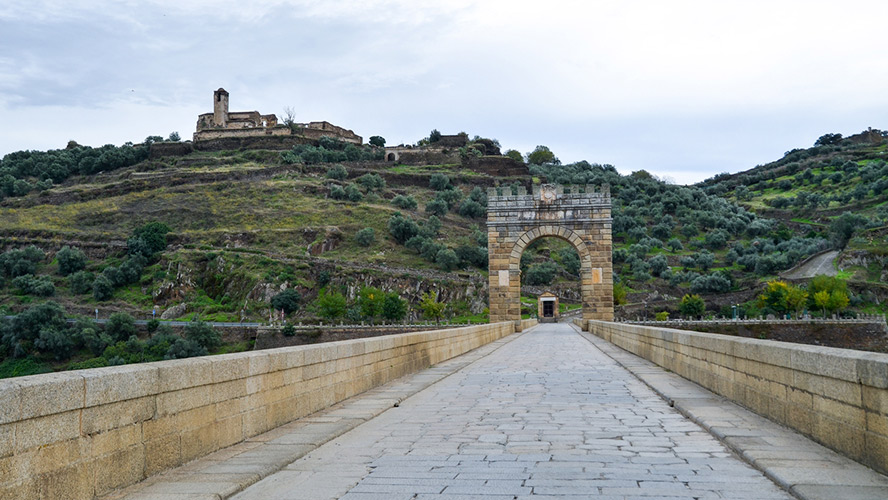
Hervás
Tucked away in Valle del Ambroz, in the province of Cáceres, sits the ancient village of Hervás. The village boasts an immaculately preserved Jewish Quarter which was declared a Cultural Heritage Site. The narrow, cobblestoned streets are lined with sun-dried brick and wood house with quaint balconies. The town is also home to the narrowest street in Spain, Travesía del Moral. It is not even 50-cm wide! Be sure to visit the 13th-century Iglesia de Santa María, built on the site of a Templar fortress.
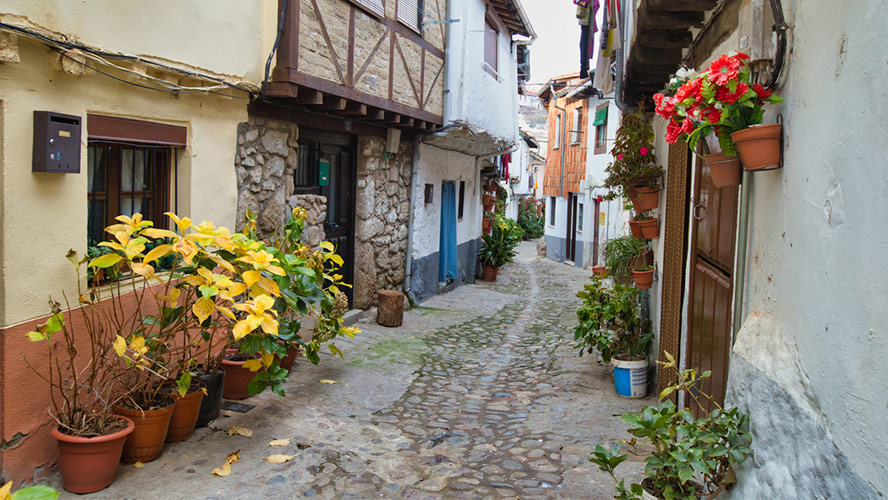
Parque Nacional de Monfragüe
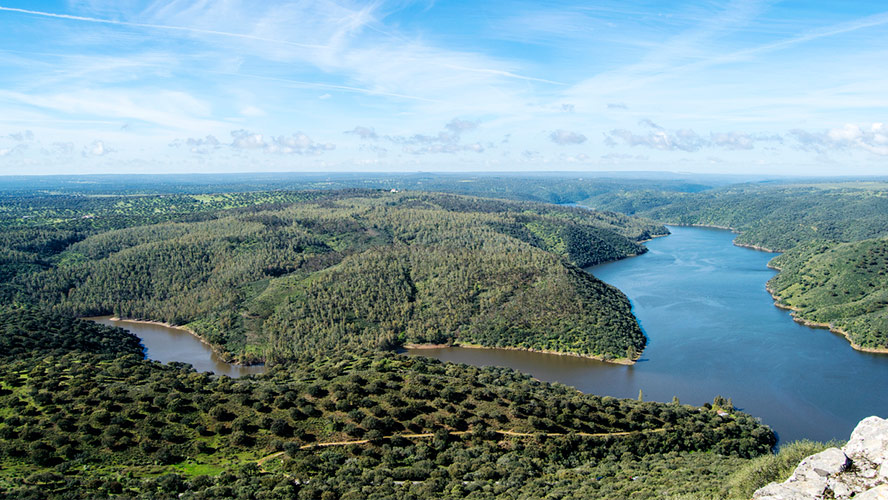
Parque Nacional de Monfragüe is a designated UNESCO Biosphere Reserve which extends over an impressive 18,000 hectares. Birdwatchers flock to this national park – a world-class reference – to observe the numerous colonies of birds of prey: the Spanish Imperial Eagle, the Black Vulture, the Adalberti’s Eagle, the Spanish Imperial Owl and the Black Stork. These majestic creatures make their homes among the Mediterranean forest and scrubland, and cork oak and holm oak woodland. The park boasts several exceptional vantage points where birdwatchers can try to spot as many species as possible. These include Salto del Gitano, Mirador del Castillo and Mirador de la Serrana. The park also offers incredible hiking trails where you can soak up the glorious landscape. The national park of Monfragüe, together with Doñana, has the richest biodiversity in all of Europe.



































































